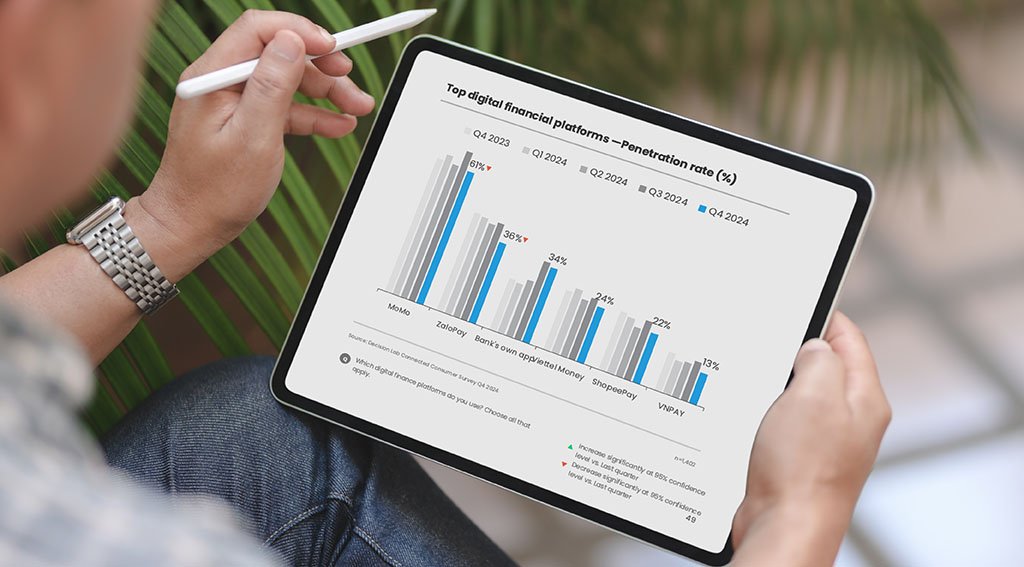In Vietnam, bank-owned apps are rapidly gaining popularity across all generations, outpacing independent fintech platforms like MoMo and ZaloPay, which are seeing a decline in usage and preference, according to a new report by Decision Lab, a Vietnamese market research firm. This shift indicates that banks are rising to the challenge, actively enhancing their digital capabilities to better meet evolving customer expectations.
The report, which surveyed more than 1,400 consumers in Vietnam in Q4 2024, found that independent fintech apps are experiencing a decline in both usage and preference. MoMo and ZaloPay saw the steepest drops, with penetration rates each falling 8 points quarter-on-quarter (QoQ). ShopeePay and VNPay followed suit, declining by 4 points QoQ.
User loyalty for these platforms is also weakening. In Q4 2024, only 40% of consumers said they used MoMo the most often, down 3 points from the previous quarter. ZaloPay saw a similar trend, slipping 2 points to a mere 9%.
Despite the drop, MoMo and ZaloPay remained the most widely used digital finance platforms in Q4 2024, with penetration rates of 61% and 36%, respectively.
MoMo is a popular Vietnamese mobile e-wallet app that claims 31 million users. That platform allows users to make payments, transfer money, pay bills, and shop online. ZaloPay offers similar digital payment services but has the advantage of being integrated with Vietnam’s leading messaging app Zalo, which boasts 77.6 million monthly active users, giving it a massive scale and reach.
ShopeePay and VNPay are other prominent digital payment platforms. ShopeePay is linked to the Shopee e-commerce platform, while VNPay is a major Vietnamese payment gateway and QR code-based digital payment system.
Bank apps rise in popularity
In contrast, digital apps developed by traditional financial institutions are rising in popularity. In Q4 2024, these platforms were the third most popular digital finance platforms in Vietnam, achieving a 34% penetration rate. The figure represents a marginal 1-point decline QoQ, significantly outperforming fintech challengers.
But most importantly, these platforms’ popularity increased. In Q4 2024, 26% of respondents said they used bank-owned apps more often than any other platforms, marking a 3-point increase QoQ. This reflects growing preference for digital offerings provided by traditional financial institutions rather than independent, digital challengers.

Older generations drive the shift
This shift is largely driven by older generations. Generation X, born between 1960 and 1980, recorded the sharpest decline in preference for MoMo, failing 8 points QoQ to 35%. Meanwhile, Millennials, or those born between 1981 and 1996, saw the preference rate for ZaloPay decline 7 points to just 8%.
At the same time, Gen X and Millennials are the biggest adopters of bank-owned digital platforms. In Q4 2024, 30% of Gen X members and 23% of Millennials indicated using bank apps as their primary digital finance platforms, up 4 and 5 points QoQ, respectively.

Traditional financial institutions step up digital efforts
This transition coincides with Vietnamese banks actively enhancing their digital capabilities to meet the challenge posed by fintech competitors, a trend that has been accelerating since at least last year.
Vietcombank, for example, implemented in 2024 a virtual assistant called VCB Digibot. Powered by artificial intelligence (AI), VCB Digibot is designed to enhance customer experience and service efficiency by providing instant, highly accurate and 24/7 responses to a wide range of frequently asked questions. In its first six months, the AI chatbot successfully handled over 2 million interactions. It now manages about 88% of user queries.
Military Commercial Joint Stock Bank (MB Bank) is also investing heavily in digital transformation, having developed a super-app that integrates over 200 mini-applications within the MBBank app. Vu Thanh Trung, Vice Chairman of MB’s Board of Directors, told the media in January that the bank is allocating approximately US$50 million per year in its digital transformation, focusing on AI, machine learning (ML) and deep learning technologies.
Finally, TPBank has partnered with Backbase to accelerate its digital transformation. This collaboration focuses on upgrading the bank’s traditional products, services, and core banking system into a secure, agile, and scalable omni-channel platform.
According to the State Bank of Vietnam (SBV), at least 96% of Vietnamese banks have devised plans for digital transformation and 92% have developed Internet and mobile application services. This suggests that the vast majority of Vietnamese banks are recognizing the importance of digital transformation and are actively planning for it.
Digital payments surge
These developments come amid a surge in digital payments and online banking. Pham Tien Dun, Deputy Governor of the SBV, said at a workshop in October 2024 that digital transactions at many commercial banks now account for 97-98% of total transactions.
The central bank also reported a surge in both mobile and QR code payment transactions, with average growth of over 100% over the past five years. Meanwhile, the National Payment Corporation of Vietnam (NAPAS), the state-backed company that operates the country’s electronic payment infrastructure, facilitated 9.56 billion transactions in 2024, representing a year-on-year (YoY) increase of 30%.
Vietnam’s banks are planning to ramp up investments in digital capabilities. Techcombank, one of the country’s largest private financial institution, told the Nikkei Asia earlier this month that it plans to increase the share of digital talent to 30% of its workforce in the next five years, aiming to tailor services more precisely to customers. The bank is also using AI to streamline financial services and operations.
Featured image credit: edited from freepik


